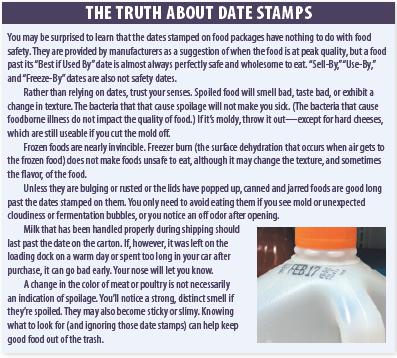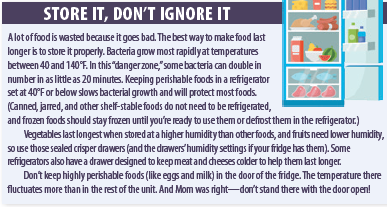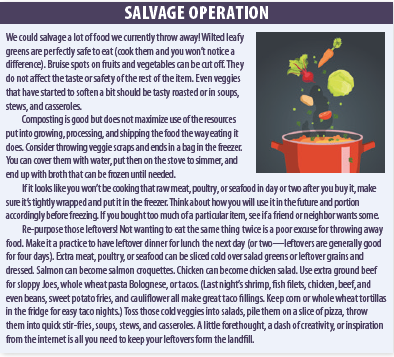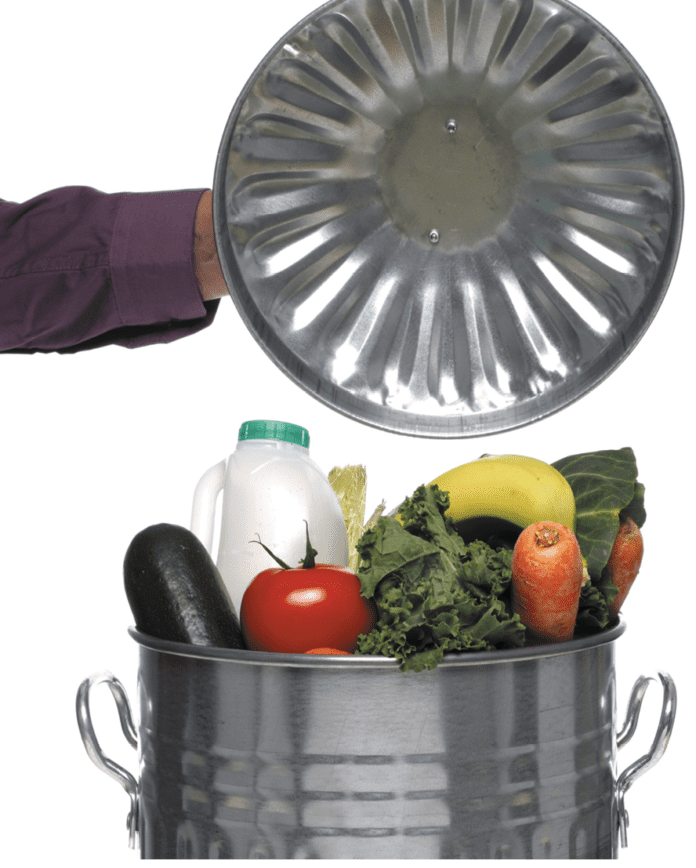Over one-third of the food produced in the United States is never eaten. On average, Americans throw away a pound of food per person per day.
All of this waste has a high cost—to our bank accounts and to the environment. Reducing food waste would save money, increase the amount of food available for people who don’t always have enough to eat, conserve natural resources and energy, decrease environmental damage, and contribute to addressing climate change.

The Environmental Cost of Wasted Food. According to a report by the federal Environmental Protection Agency (EPA), the resources that go into a year of wasted food in the U.S. use enough water and energy to supply more than 50 million homes.
Producing the foods we eat involves use of agricultural land, water, and energy. Data collected by University of Oxford researchers and the non-profit Global Change Data Lab indicate 50 percent of the worlds habitable land is used for agriculture and 70 percent of the freshwater used worldwide goes to growing food and raising livestock. Throwing away food wastes all of those resources.
Food production also requires the use of fertilizers and pesticides. Eutrophication (pollution of bodies of water by excess nitrogen and other nutrients from agricultural production) is a major environmental problem. Seventy-eight percent of global ocean and freshwater pollution comes from agriculture.
Food production also creates greenhouse gas emissions (the primary driver of climate change) at every stage of the process: deforestation and soil cultivation; the methane produced by cows and rice; food processing and package manufacturing; the fuel used in farming, shipping, food delivery, or a trip to the grocery store; the energy used in cooking; and emissions given off by food waste all contribute to the nearly one-third of the world’s greenhouse gas emissions that come from food systems. The greenhouse gas emissions from one year of food waste in the U.S. alone are equivalent to the emissions from 42 coal-fired power plants.
Why We Waste. There are many reasons we end up wasting foods (one study came up with over 90 factors that may influence our food-wasting behaviors). Perhaps we bought more food than we needed or prepared too much and didn’t reuse the leftovers. Maybe our schedule or plans changed, and we didn’t get to cook the fresh food we’d bought. Or we may throw out food because we’re worried about foodborne illness or spoilage because it is past the date on the package stamp (see “The Truth About Date Stamps”).
We can’t do much to control factors like unpredictable schedules or lack of access to supermarkets, but we can shop with an awareness that larger package sizes and food promotions (like “Buy One, Get One” sales) are associated with more food waste while meal planning, more knowledge about food storage, and a well-organized fridge and pantry are associated with less.

In 2020, the National Academies put together an expert committee to develop a national strategy to reduce food waste at the consumer level. The committee’s report acknowledged that consumer behaviors that lead to food

waste are complex and varied and that we do not yet have enough evidence to know which interventions will be the most effective at changing the nation’s wasteful habits. They identified 11 categories that show promise for interventions. Along with marketing practices and government regulations were several factors that are under your control. These include “consumers’ recognition and monitoring of their food waste”, their knowledge, and “the convenience or inconvenience of reducing food waste as part of daily activities.” You now know the scope and impact of the food you waste and how to cut that waste. It’s up to you to decide if you are willing to change some of your purchasing, storage, and preparation habits to reduce food waste.
➧ Get creative. Repurpose and reuse leftovers from home or from restaurants.
➧ Shop smart. Buy less. Rethink impulse purchases. Make sure you can actually use the amount of food you get with a bulk or buy-one-get-one item (if you throw it out, you haven’t actually saved money).
➧ Store it right. Keep cold foods cold, and use your refrigerators features to help foods last longer.
➧ See it. Storing food in clear containers and organizing the fridge and pantry so items are visible may help reduce waste.
➧ Plan ahead. Have a plan for all the food you buy and bring into house, especially fresh foods.Include canned and frozen fruits and veggies.
➧ Ignore “best if used by” dates. Rely on your senses to determine if a food has spoiled.
➧ Freeze it. If you don’t think you’ll use it in time, freeze it. Animal proteins, bread, veggies that have been blanched (briefly exposed to boiling water), and berries all freeze well.
➧ Shoot for progress. Nobody is perfect. Think about what you’re typically wasting and identify small changes you are willing to make to cut that waste.
























